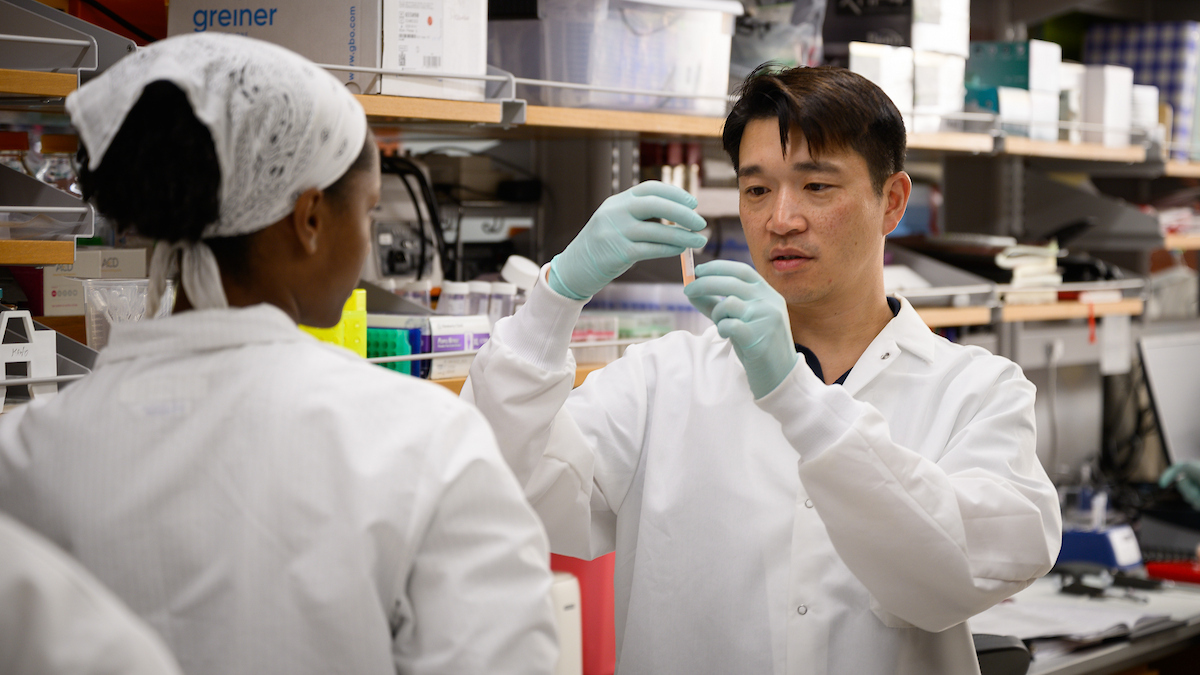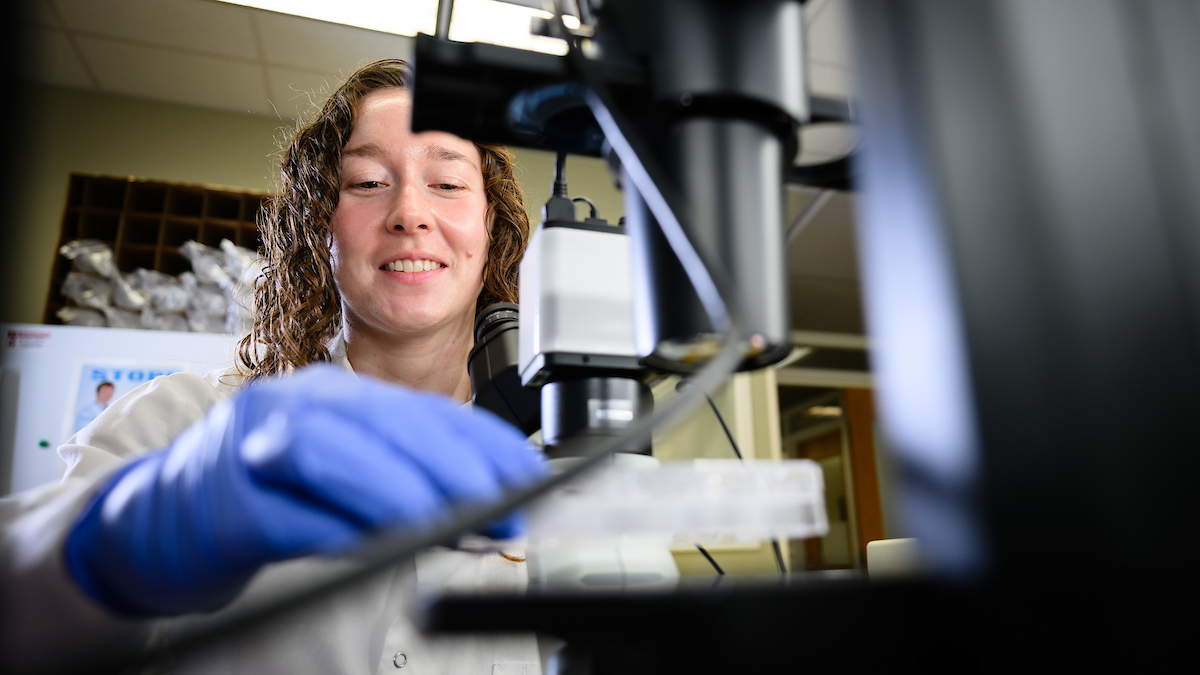CVM Neurobiologist Maps Areas of the Brain Associated with Affective Aggression in Mice
A North Carolina State University College of Veterinary Medicine researcher has created a roadmap to areas of the brain associated with affective aggression in mice. This roadmap may be the first step toward finding therapies for humans suffering from affective aggression disorders that lead to impulsive violent acts.
 Affective aggression differs from defensive aggression or premeditated aggression used by predators, in that the role of affective aggression isn’t clear and could be considered maladaptive. NC State CVM neurobiologist Dr. Troy Ghashghaei was interested in finding the areas of the brain engaged with this type of aggressive behavior. Using mice that had been specially bred for affective aggression by his research associate Dr. Derrick L Nehrenberg, Dr. Ghashghaei and former undergraduate student Atif Sheikh were able to locate the regions in the mouse brain that switched on and those that were off when the mice displayed affective aggression.
Affective aggression differs from defensive aggression or premeditated aggression used by predators, in that the role of affective aggression isn’t clear and could be considered maladaptive. NC State CVM neurobiologist Dr. Troy Ghashghaei was interested in finding the areas of the brain engaged with this type of aggressive behavior. Using mice that had been specially bred for affective aggression by his research associate Dr. Derrick L Nehrenberg, Dr. Ghashghaei and former undergraduate student Atif Sheikh were able to locate the regions in the mouse brain that switched on and those that were off when the mice displayed affective aggression.
“The brain works by using clusters of neurons that cross communicate at extremely rapid rates, much like a computer,” explains Dr. Ghashghaei, an assistant professor of neurobiology in the Department of Molecular Biomedical Sciences. “One region will process a stimulus, and then that region sends messages to other clusters within the brain, like circuits within a computer. We looked at how the switches flipped in the brains of aggressive mice, and compared that with the brains of completely nonaggressive mice in the same setting, to see how the two processed the situation differently.”
They found that affectively aggressive mice demonstrated a large difference in the way their “executive centers” operated when the mice encountered another mouse. “Sensory inputs come in and are sent to the executive center, the part of the brain that decides how to respond to the input,” Dr. Ghashghaei says. “In the meantime, the information about the response you made gets processed back with either a pleasant or unpleasant association.”
According to Dr. Ghashghaei, a research scientist with the Center for Comparative Medicine and Translational Research, the affectively aggressive mice could react violently because their brains are hardwired to respond to certain situations aggressively without assessing whether their response to the situation is appropriate or without regard to the behavior’s consequences. In addition, affectively aggressive mice may be forming pleasant associations with their violent displays, which would reinforce their aggressive tendencies.
 “We cannot say which of the two possibilities underlie the persistent aggressive displays by our mice,” Dr. Ghashghaei says, “but we can see that the patterns of neuronal activity are very different in the executive centers of these mice. Additionally, there are differences in the neuronal clusters involved with creating pleasant or unpleasant associations to the stimulus or their response. That gives us a few starting spots to begin identifying the mechanisms that underlie these profound behavioral differences.”
“We cannot say which of the two possibilities underlie the persistent aggressive displays by our mice,” Dr. Ghashghaei says, “but we can see that the patterns of neuronal activity are very different in the executive centers of these mice. Additionally, there are differences in the neuronal clusters involved with creating pleasant or unpleasant associations to the stimulus or their response. That gives us a few starting spots to begin identifying the mechanisms that underlie these profound behavioral differences.”
The regions of the brain that were involved in affective aggression in the mice are similar across all mammalian species. Dr. Ghashghaei hopes that his findings in mice will be useful to researchers studying violent behavior in humans, as well as aggression in other animals.
“With the brain, just knowing where to start looking is huge,” Dr. Ghashghaei says. “Once you have a few targets, you can tease out the possibilities and get to the heart of the problem. We are confident that manipulation of some of the identified targets in our study will disrupt displays of affective aggression in our mouse model.”
The researchers’ findings appear online in Brain Structure and Function.
The Center for Comparative Medicine and Translational Research, located on NC State’s Centennial Biomedical Campus, is a community of more than 100 scientists from five NC State colleges. These investigators are involved in collaborative ”One Medicine” studies with government, private, and other academic researchers to advance knowledge and practical applications that improve the health of animals and humans.
[section_subtitle] Abstract: [/section_subtitle]
“Identification of neuronal loci involved with displays of affective aggression in NC900 mice”
Authors: Derrick L. Nehrenberg, Atif Sheikh, H. Troy Ghashghaei, Department of Molecular Biomedical Sciences and Center for Comparative Medicine and Translational Research, College of Veterinary Medicine, North Carolina State University, 1060 William Moore Dr, Raleigh, NC 27607, USA
[section_subtitle] Published: Brain Structure and Function [/section_subtitle]
Aggression is a complex behavior that is essential for survival. Of the various forms of aggression, impulsive violent displays without prior planning or deliberation are referred to as affective aggression. Affective aggression is thought to be caused by aberrant perceptions of, and consequent responses to, threat. Understanding the neuronal networks that regulate affective aggression is pivotal to development of novel approaches to treat chronic affective aggression. Here, we provide a detailed anatomical map of neuronal activity in the forebrain of two inbred lines of mice that were selected for low (NC100) and high (NC900) affective aggression. Attack behavior was induced in male NC900 mice by exposure to an unfamiliar male in a novel environment. Forebrain maps of c-Fos+ nuclei, which are surrogates for neuronal activity during behavior, were then generated and analyzed. NC100 males rarely exhibited affective aggression in response to the same stimulus, thus their forebrain c-Fos maps were utilized to identify unique patterns of neuronal activity in NC900s. Quantitative results indicated robust differences in the distribution patterns and densities of c-Fos+ nuclei in distinct thalamic, subthalamic, and amygdaloid nuclei, together with unique patterns of neuronal activity in the nucleus accumbens and the frontal cortices. Our findings implicate these areas as foci regulating differential behavioral responses to an unfamiliar male in NC900 mice when expressing affective aggression. Based on the highly conserved patterns of connections and organization of neuronal limbic structures from mice to humans, we speculate that neuronal activities in analogous networks may be disrupted in humans prone to maladaptive affective aggression.


